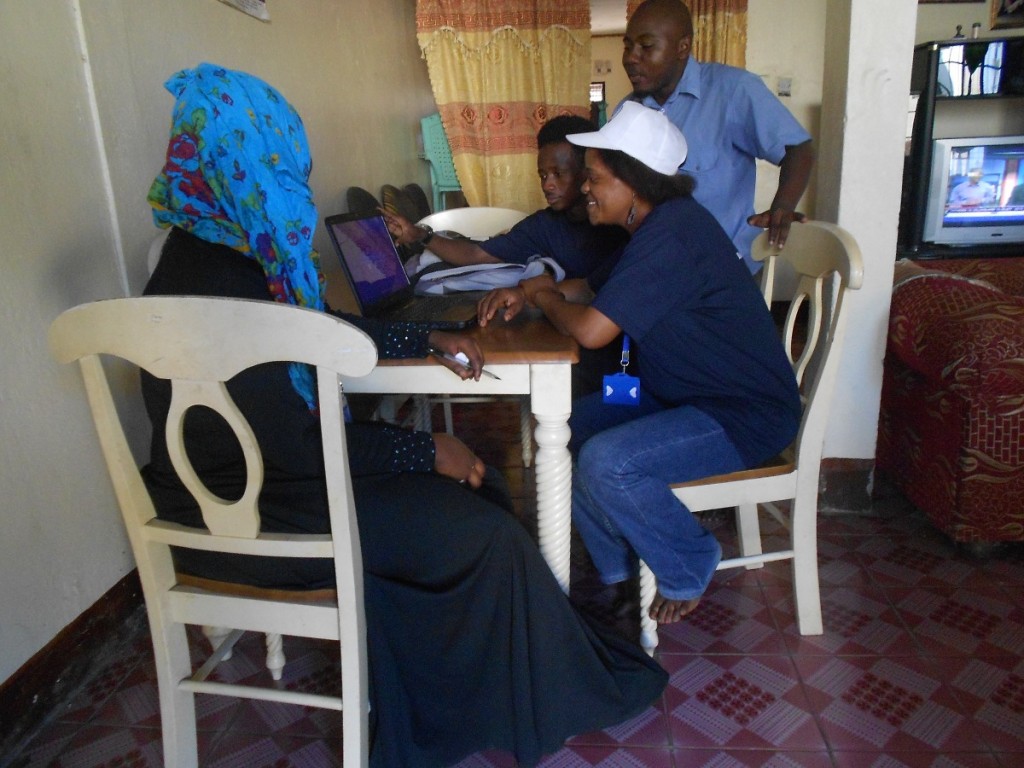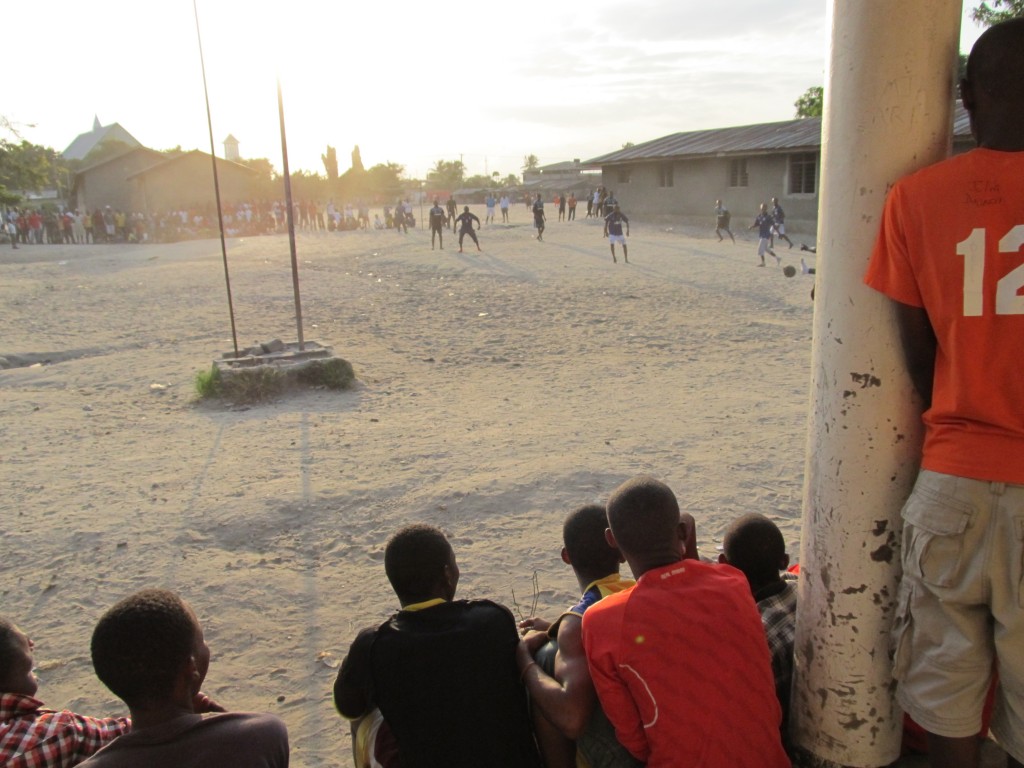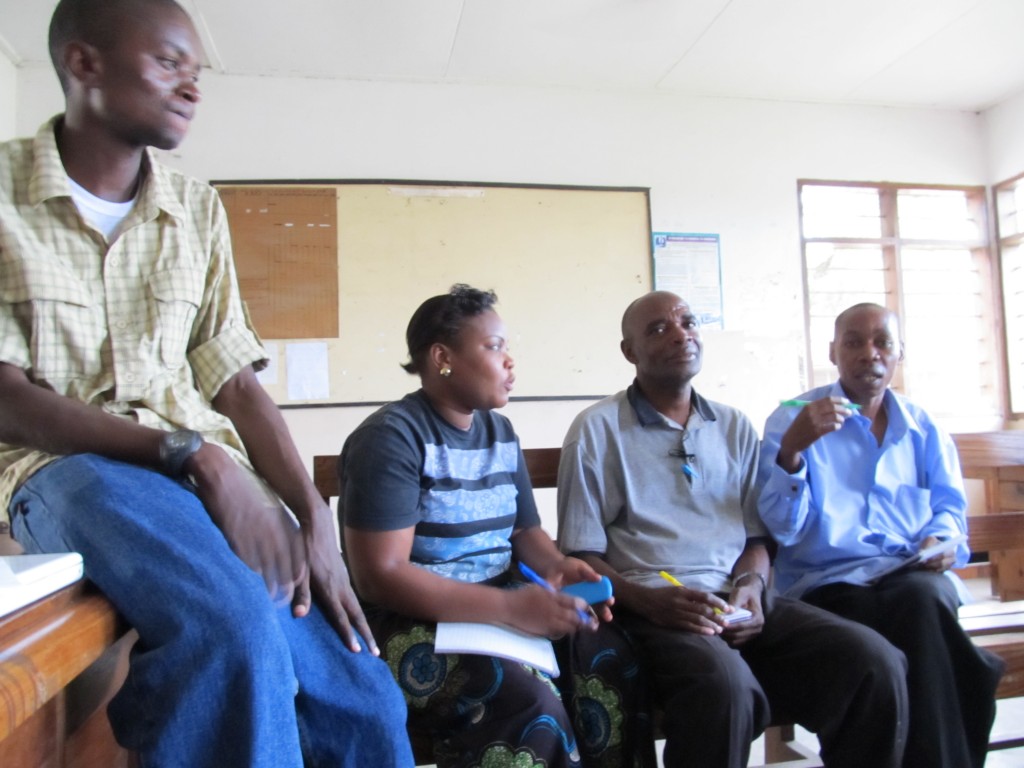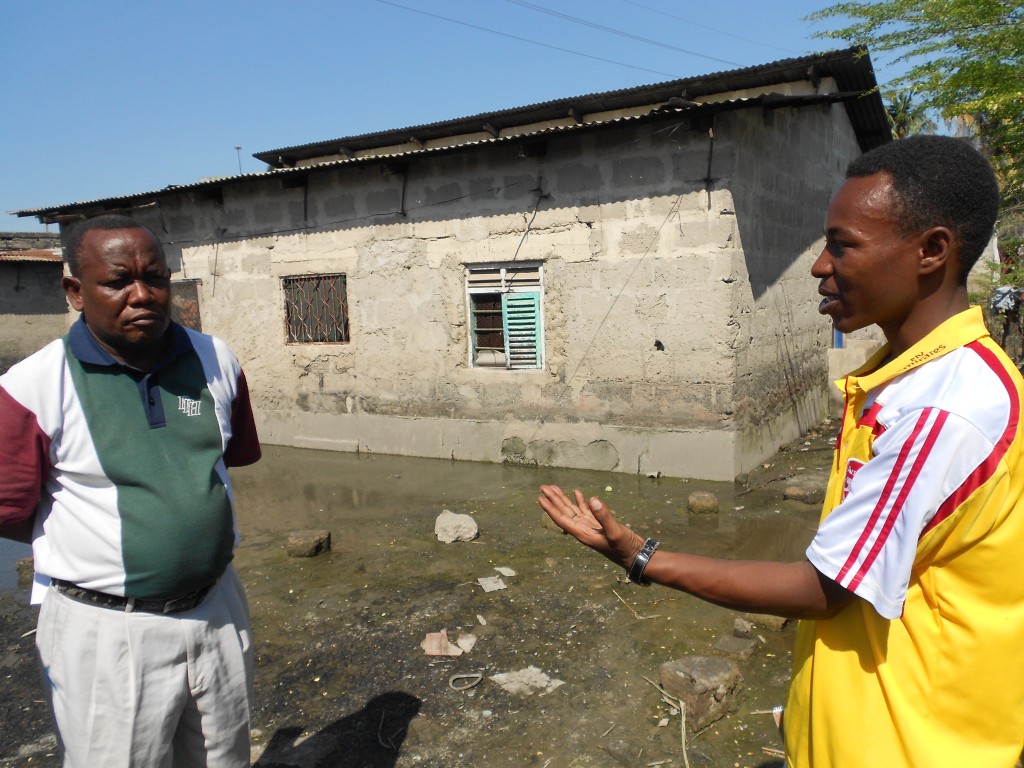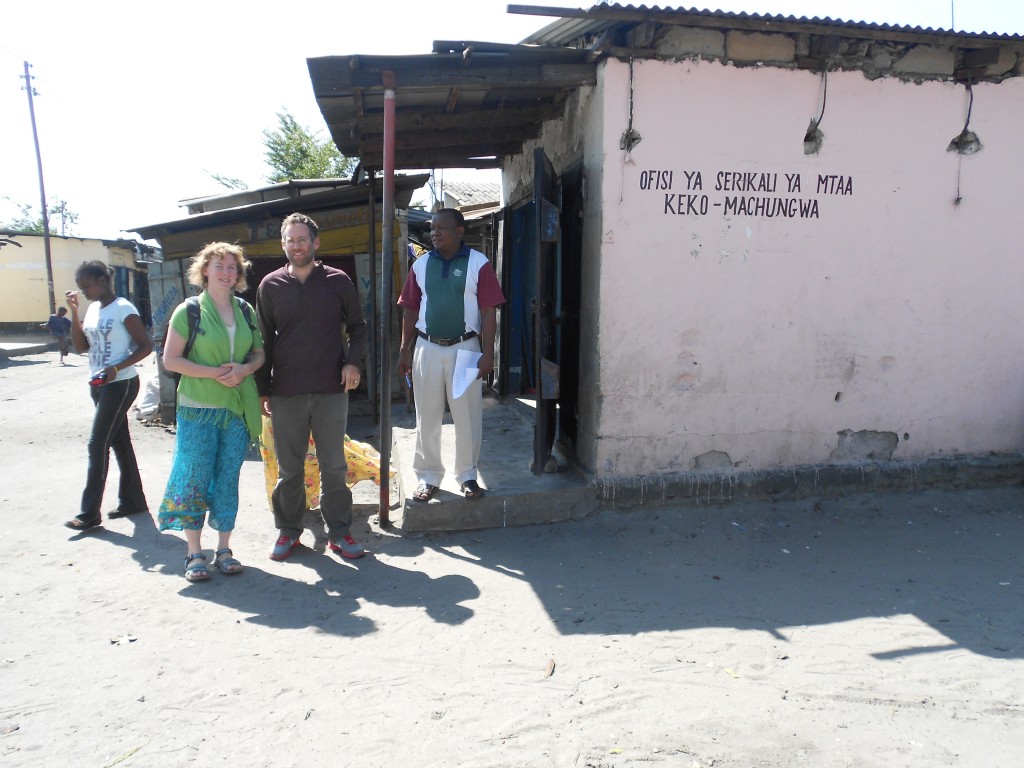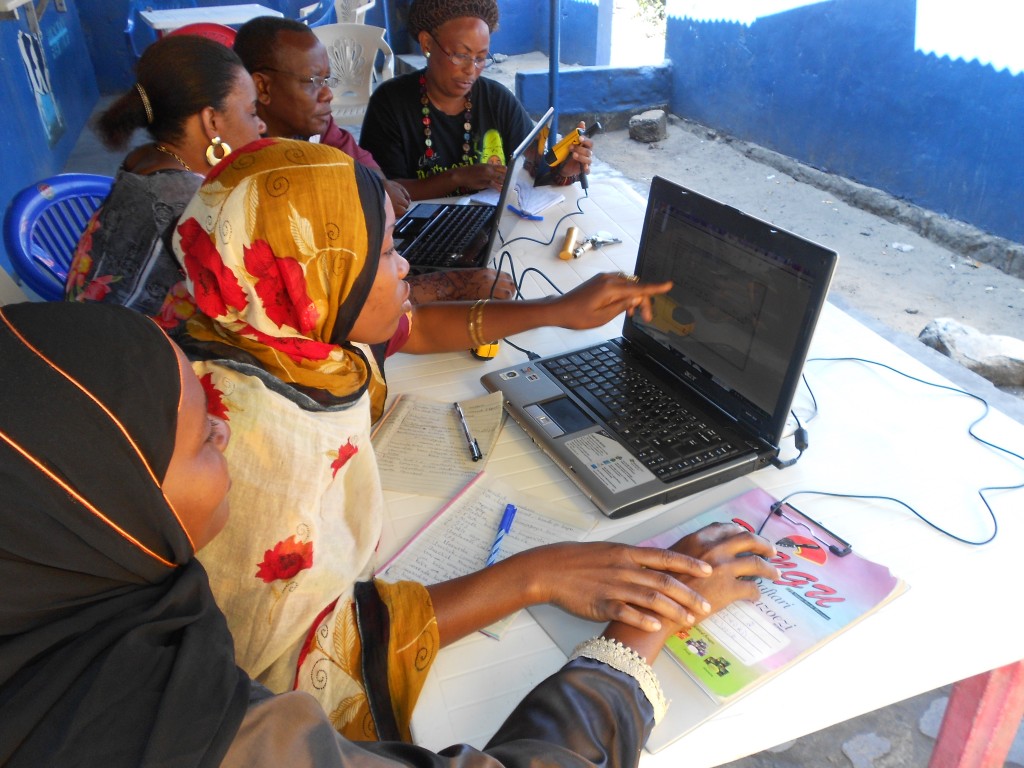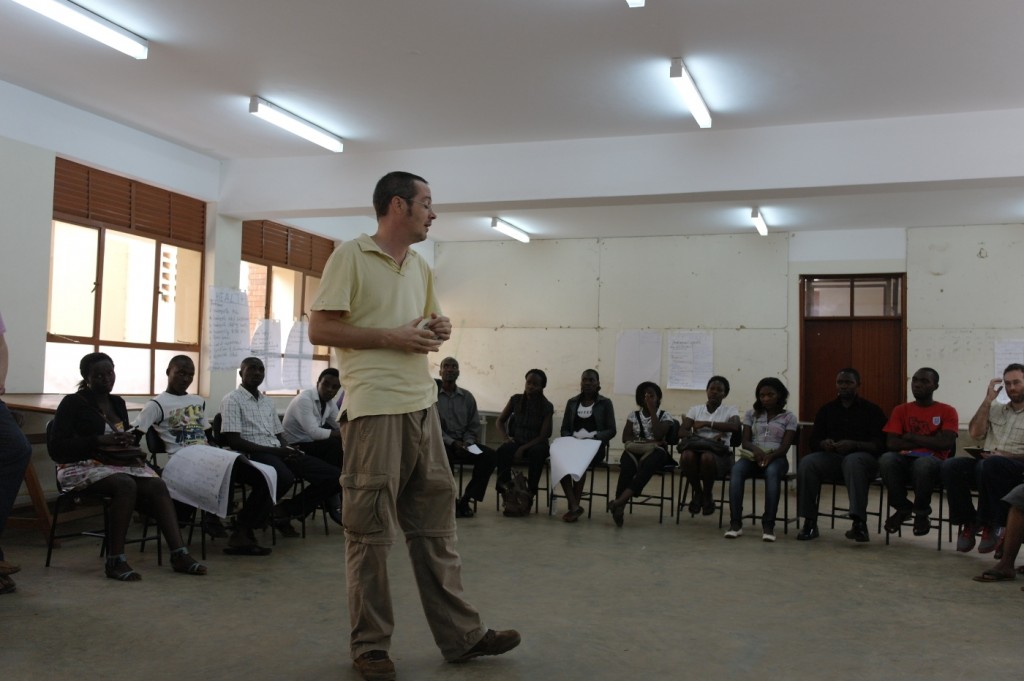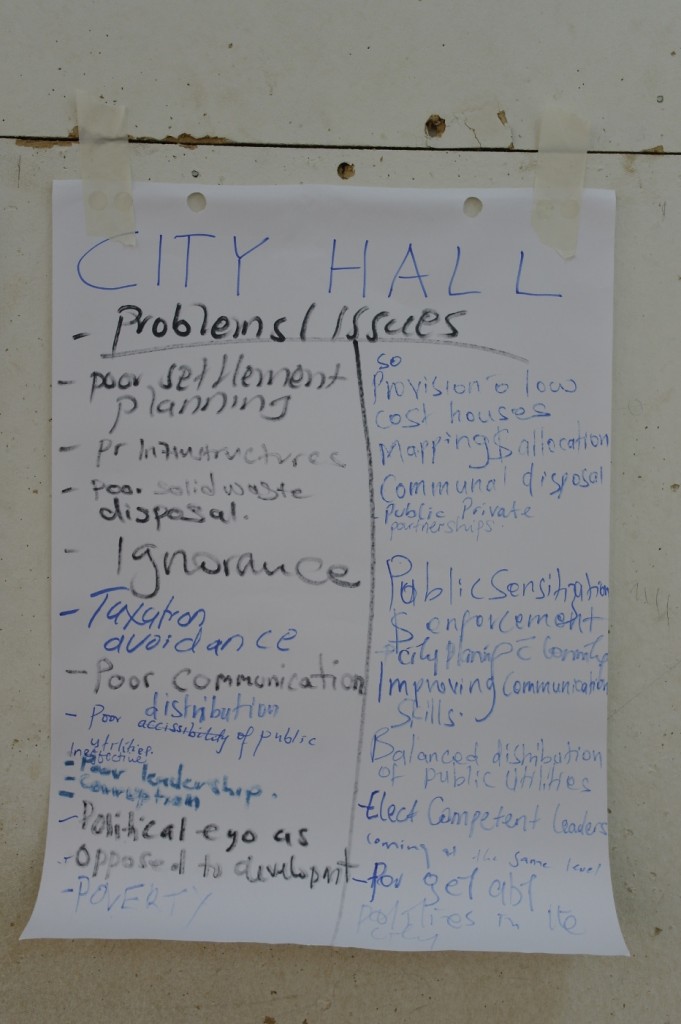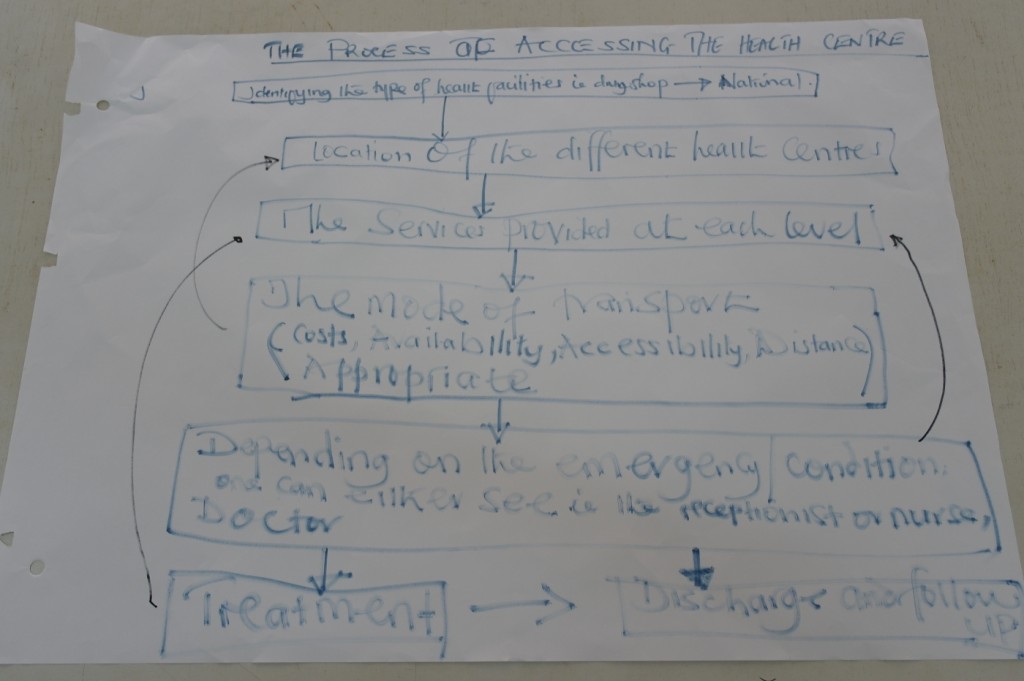Msilikale and Equipment in Dar
Posted: July 27th, 2012 | Author: mikel | Filed under: tandale, Tanzania | Tags: Tandale | Leave a comment »When we returned to Dar es Salaam last month, we planned to assist a variety of partners to build a much larger and more sustainable program in the city based on the Tandale pilot. This continues, but may take some time to develop. So, at minimum we committed ourselves to put in place the means for the Tandale community to be able to continue to map and report. The key missing pieces were equipment, and someone to help out. The fine folks at MapBox lent a hand on the equipment side, with a small donation towards two sets of laptop-GPS-camera-modems for use in community work in Dar es Salaam. ASANTE!
Some snaps from Tandale of mappers getting to grips with their new equipment.
We were also able to bring on Msilikale Msilanga part time to help out with keeping things going in Tandale. We also loaned out some GPS devices to CCI for them to use as they continue to work on mapping with one of our previous trainees, Reginald, in Keko Machugwa.
Here’s Msilikale in his own words….
Who am I?
I participated in the Tandale Project from Ardhi University, as a student during that time. I now have a Bachelor of Science in Urban and Regional Planning, with knowledge and experience of mapping using different software such as QGIS, MapInfo, etc, as well as knowledge of OpenStreetMap. I am now helping the Tandale community with reporting and mapping Tandale.
What I am doing in Tandale
The following are the activities that I am doing to help the community who are interested to do more mapping using OpenStreetMap and reporting using the blog and Ushahidi.
1. Â Train the Tandale community every Sunday
This is one of the things I have decided to do because most of the community who participated in the project had the knowledge from the training in the project, but it has been a long time now and they don’t remember how to use the equipments. So I am training them every Sunday when they are free.
2. Â Helping the interested community when they fails
The Tandale community see me as part of their family, so whenever they fail in anything especially mapping and reporting, they can contact me at any time and I help them through the mobile phone especially when they want to use the equipments and they don’t know how to go about it.
3. Â To connect the Tandale community with Ground Truth (GT) and Centre for Community Initiatives (CCI)
Because I can also communicate with Ground Truth and CCI now, I am acting like a bridge to bring the community feedback, and if there is a problem I am the one to report to either CCI or Ground Truth.
4. Â To take care of the equipments
If one of the equipments has a problem the community reports to me. If the problems are from technical (the computer is not working for example) I can solve that problem, but if I fail to solve the problem I contact Ground Truth or CCI for help.
5. Â Encourage the community in what they are doing
This is to help them to do more mapping and reporting and reminding them the importance of doing it.
6.  Find the way to make these reports to be heard by responsible people
This can be the government, or  NGO or CBO, that can help in any way with the problems raised by the Tandale community; even facilitating meetings with the bloggers so that to make Tandale voice to reach far and get help.
Dar es Salaam: Tandale and beyond
Posted: July 24th, 2012 | Author: Erica Hagen | Filed under: tandale, Tanzania | 1 Comment »GroundTruth recently returned from a trip that included a lovely stop in Dar es Salaam, Tanzania.
Last year, the World Bank and Twaweza sponsored a brief mapping pilot there which was completed by GroundTruth in partnership with Map Kibera Trust. On the community side, the pilot involved a partnership with a local associate of Slumdwellers International known as the Center for Community Initiatives. The Tandale mapping exercise, while successful in many ways, unfortunately did not continue beyond the pilot month as hoped. This was partly due to the unfortunate destruction of all of the mapping and computer equipment in the massive floods of December 2011.
We were therefore excited to be able to return this June, again in partnership with the World Bank, and take a look at the successes and failures of the pilot and possibilities for growth in Dar.
While the mapping process initiated last year was very much based on the Map Kibera work in Kenya – for example, training community members to do their own mapping and involving the community in forums to share ideas and results, there was also a new element: involving University students. We made a point of engaging the Ardhi University students of Urban Planning in such a way that they were learning alongside an equal number of residents of Tandale, exchanging knowledge and learning about the issues in Tandale. It was a great practical experience for students. Meanwhile, Tandale residents appeared to appreciate the attention from students and their help in getting the important local issues mapped and recognized.
During our recent trip, it was clear that for some students, the relationship with the Tandale community leaders (and the multiple challenges they face in areas like sanitation, wastewater management, infrastructure, and more) had made a strong impression. A few students had continued to talk to some of the residents and try to find ways to support their continued work, without institutional support but purely under their own initiative. This was encouraging, and a great signal of success or potential success. One student, Msilikale Msilanga, had even returned to Tandale several times and made reports via both email and on the Tandale Blog about various emerging concerns.
Part of our enthusiasm to return to Dar was therefore to help Msilikale and other motivated students to continue to support the most motivated community members and build off the ground work laid last year. GroundTruth brought some new equipment (partly donated generously by Development Seed) to support this goal.
One of the first things I did was to visit Tandale and ask the participants there about their experience last year. Not surprisingly, the main thing they wanted to talk about was the failure to establish a means of accessing any equipment after the pilot. In a place like Tandale, cybercafes are rare or distant. Certainly, accessing something like a GPS or a software like JOSM would not have been possible independently.
I explained (along with Mark Illife, the primary GT trainer last year) that unfortunately Mark had taken very ill and had to leave quickly at the end of the pilot; meanwhile, no suitable location to store equipment had been agreed upon. It might seem like a simple thing: find someone/someplace who can properly care for, house, and monitor access to a few pieces of equipment: laptop, modem, GPS, camera. The truth is, however, it’s not simple at all. In fact, we have spent a great deal of time and effort during and since our trip to resolve this same issue with the new equipment that we brought. We will wait and see if the plan succeeds. The problem is that in Tandale (like other informal settlements in Dar) there are few offices or community-based organizations which might suitably house equipment. The Ward Office was a great host, but it closes around 5 pm and on weekends, when most participants are free. Situating equipment means establishing a close partnership and contractual agreements, which also takes time (and is what we’ve done this time through).
It’s very important to realize that in a community like Tandale, or perhaps any time you are working alongside community members – that is, in a geographically defined area where people are associated together in various ways, and know each other, and face the same problems day to day – it’s not sufficient to simply bring in a “pilot” and then showcase the results without continuity. This is a main premise of Map Kibera as well. One is entering into the lives of people and introducing something in hopes of having lasting impact. I was glad to see that residents were still enthusiastic that the pilot could still lead to something nearly one year later, and that GT was able to find a way to continue.
I then supported Msilikale and two other former Ardhi students in running two new training sessions on reporting using the Tandale blog and Ushahidi instance, Ramani Tandale. These sessions were very exciting. Participants had a LOT to say about their community. We not only introduced technology, but spent a good deal of time coming up with story ideas, thinking about what and how to tell the stories, and writing them out in small groups.
Combining some of the community “elders” – members of the Slumdweller Federation group or other local leaders – with more computer-savvy local youth was very fruitful. The elders had many story ideas, as though they had just been waiting for someone to ask. They finally had a public way to air their grievances and talk about their hard work through the Federation chapter. Meanwhile, the youth could quickly type and pick up the posting skills.
Tandale, it should be mentioned, is really not much like Kibera. The population is smaller and the area is less dense; community leaders work closely together with the Ward Officer and other local political figures; the social problems one finds are less contentious, less likely to involve violence or conflict. The feel is more rural or village. This is my impression, and it tends to extend over the whole of Dar. Dar is no Nairobi, and any program should be adapted to this variation in how things get done. Above all: people rely on, and trust government far more, relatively speaking.
Another exciting development since our work last year was that CCI had already hired one of the Ardhi students to help them produce a similar map in another settlement where they were working, Keko Machungwa. CCI, like others affiliated with Slumdwellers Federation, assists slum residents to collect and use local information to determine their own development needs and find ways to serve them, or to band together and advocate for change. CCI was also excited about the possibilities of local reporting and media to highlight these issues, so we’ve partnered with them in our recent bid for the Africa News Innovation Challenge. We were glad to see that mapping was actively underway, and local leaders were watching us work on online reporting tools in Tandale. Blogging was in high demand.
Following up on Tandale was only one reason for the visit. We had also contracted with the World Bank to help advise on the future of mapping and reporting in Dar, especially with regard to the strategy for engaging Universities. We spent a good deal of time meeting with interesting organizations like KINU, a new tech “hub” space and tech entrepreneurship support; TanzICT, a Finnish government support to the Tanzanian government’s COSTECH ministry; Twaweza, and others.
It was exciting to see that Dar is beginning to get a bit of the Nairobi tech fever, but given its unique culture and social context, the innovations that come out of Tanzania are bound to be different. Those which are adopted will also be uniquely Tanzanian. Anyone who has visited these neighboring countries cannot help but notice the stark difference in cultural “personality”, like two twins who grow up as opposites. Risking a bit of essentialism…I can’t help but think Nairobi is like the athletic, popular and brassy twin, outgoing and ambitious but liable to get into big trouble from time to time, always on the hustle. Dar is the quiet one, thoughtful and introverted, always generous, laid-back and daydreamy.
We witnessed a bit of the differences at an event set up by TanzICT, KINU and COSTECH to publicize the Africa News Innovation Challenge. The event brought together journalists and young software developers to brainstorm some ideas to apply to the challenge. We’ve watched Nairobi’s iHub, now featuring several such events a week, grow up from just an empty space in 2010. Now this new space in Dar has just gotten off its feet. It’s therefore exciting to see what can come of it. I don’t think of this as being “behind” or “lagging” at all, I believe that Dar’s tech scene will certainly have its day and possibly will quietly issue in some of the more effective ICT and media projects and ideas. There are benefits to being just out of the spotlight yet close enough to watch and absorb. Msilikale was able to entertain the crowd with his presentation in Swahili about Tandale, including the new blog posts and Ushahidi posts on Ramani Tandale.
We’re certainly going to keep watching. GroundTruth recently posted an application to ANIC which would bring together Map Kibera and CCI in an exciting new community-based reporting platform designed to meet the needs of both Dar and Nairobi informal settlements. A revolution in networking and raising the voices of slumdwellers is brewing, and we hope to be able to support it in any way we can.
Data.Gov and Wikimania
Posted: July 19th, 2012 | Author: mikel | Filed under: events, talks | Leave a comment »
Busy conference week last week with Wikimania and Data.gov.
At Data.gov, gave this presentation, (and video, “Policy Track – Engagement Around Open Data”, around minute 35:00), another variation on the theme of how open community mapping represents a fundamental change to dynamics of development. Keeping with the theme of government open data, this time looked a bit more in depth at how OpenStreetMap and governments interact. Video coming soon.
Impressed with the level of discussion around OpenData. We are steadily moving past the hype (even if we’re still amazed that the Secretary of State gives speeches about Data), and grappling with the real issues of using data … both technically and especially organizationally. Enjoyed sharing the stage with Nathaniel Heller and Steven Davenport for our panel, actually had a really engaging discussion with the audience, maybe due to a combination of Tim Davies skillful facilitation and our unabashed optimistic cynicism. Linda Raftree has a good summation of the emergent themes of the conference. This built on well from the Open Data for Development Camp event back in Nairobi, anniversary of OpenDataKE; iHub research is doing a nice series on the search for real impact in Open Data.
Enjoyed giving this talk at Wikimania (video, slides). Wikipedia is OpenStreetMap’s “big sister”, and we have so much to learn from them. My other experience of Wikimania was in Alexandria back in 2008, which created the opportunity to throw the first mapping party in Egypt (before GPS was legalized!). I took the opportunity to not only go over the familiar ground of OSM, OSM+Gov, OSM in development, but also look at how OSM and Wikipedia communities converge and diverge; Frederik does a more thorough write up of these two communities. Also had the opportunity to learn about the amazing mapping work happening within Wikipedia, including localized maps based on OSM, and the mind-blowing features of WikiMiniAtlas.
Makerere Workshop, Connecting with Service Providers
Posted: July 17th, 2012 | Author: mikel | Filed under: events, uganda | Leave a comment »This post, written in collaboration with Kim Nooij of Fruits of Thought, dives deeper into one corner of the Makere Workshop, which brought “service providers” directly into the mix.
The idea was for teams to rapidly get a sense of the challenges of real life urban problems, brainstorm ways that maps and reporting tools could improve processes, and design a map and process with a close look at real implementation.
Reinier Battenberg facilitated the session, setting the goals, and giving each guest a chance to present their work and challenges
- Umeme Ltd is the biggest energy supplier in Uganda with national coverage (excepting Northwest of Uganda), directly providing power to consumers, downstream of energy producers. This means they take the full force of public frustration when there’s a problem anywhere in the system. They deal with issues like power theft and old decaying power poles, billing complexities, and challenging customer service.
- Makindye Division is one of the 5 divisions in Kampala with approximately 600,000 residents. One main issue is sanitation: cleaning trenches, collecting garbage and emptying public toilets in the informal settlements. Lack of adequate sanitation has led to malaria outbreaks, and citizens have no option but to dump trash clandestinely at night. Structures are constructed at night, encroaching on land set aside for dumping.
- National Water & Sewerage Corporation, providing services nationwide in Uganda, are held responsible clean water, but without clear development plans from Kampala and other cities, it’s unclear where infrastructure investments should be made. They want to connect the 37 informal settlements in Kampala, but don’t know where they are, how many people live there, or what services they already consume. Coordination with other service providers is lacking, yet they’re all interconnected.
- Women in Uganda Network (Wougnet) suports women’s groups, with one focus on the accessibility of health facilities and medical services. It’s often not known what services are in which place, or whether drugs or doctors are available. There’s much to improve in connected the right services to patients.
- Finally, Kepha Ngito. Executive Director of Map Kibera Trust brought out some of the challenges directly facing residents of informal settlements, who have difficulty coordinating and prioritizing needs for the community, and effectively engaging with service providers and authorities.
We broke out into “speed geek” mode, with each service provider rapidly engaging with a 1/5 of the group for 5 minutes, brainstorming possible ways that the tools could address their issues. The first switch raised groans of frustrating at the premature end of good conversations, but the group soon got charged up and rapidly dived into each new setting. The frustration is part of the effectiveness of the technique, brains and mouths start working faster and everyone is eager to share more and dive into more details. Coffee break was really high energy, leading to a second phase of more in depth discussion with only one group. The teams sat together for 45 minutes, to choose a “map” and “process” to design and present back to the group. We gave them four questions to consider:
- How does the process work?
- Who are the stakeholders?
- Who contributes to the map?
- Who uses the map during the process?
For us facilitators, it was fascinating to bounce from one group to the next, sampling the different directions and tenor of discussions. In part due to the personalities of the service provider and students, in part due to the nature of the issue, the discussions ranged from somewhat top-down, to participation among everyone, to even a bit contentious. And that was totally all right, since in practice you’d see this breadth of group dynamics anywhere.
It came time for all the groups to report back.
The Umeme team drafted this detailed workflow of how their customers receive feedback of power issues. Using map data, customers and problems can be located, and along with time estimates can be shared with customers, both on request when customers call in, or pushed out to areas where problems are happening.
Makindye Division looked at better communication on issues within the community, and more community involvement through partnerships with local organizations and mapping.
National Water & Sewerage covered the challenge of coordination, and how maps and data sharing could lead to more cooperation between service providers.
The Wougnet team focused on access to health facilities, and the difficulty of receiving treatment when the only choice is long travel to several health centres to find where the right services are provided. The processes designed looked at increasing public awareness about the supply of drugs and services provided in each center through systems to document stock and locations.
Finally, the Kibera team talked about mapping and reporting tools deployed into the community … sounds familiar.
It was a really engaging morning, and while we didn’t crack the ultimate solution to any of these challenges, I think everyone came away with a better understanding of the challenges these service providers face, and some of the potential ways to address these issues with not only technology like maps and reporting, but consideration for how such tools fit into the entire system.
Sincere thanks to everyone.
From here, we’re hoping that the pieces come together soon for this practical learning to continue at Makerere. More to come.
Community Mapping: Frequently Asked Questions
Posted: July 16th, 2012 | Author: Erica Hagen | Filed under: Uncategorized | 5 Comments »Community Mapping is not a new term, but it seems to be enjoying a makeover due in part to the impact of new citizen-led mapping efforts, like Map Kibera, GroundTruth, and others using OpenStreetMap all over the world. It’s been popping up everywhere lately, so I thought it might be time to look into just what IS community mapping, exactly?
Policy Link reported back in 2002 that:
The terms community mapping and GIS are often used interchangeably. We define community mapping as the entire spectrum of maps created to support social and economic change at the community level, from low-tech, hand-drawn paper maps to high-tech, database driven, internet maps that are dynamic and interactive.
Meanwhile, an organization called Center for Community Mapping uses mostly Google maps to build software and then license it to others to use, with the expressed purpose of “empower(ing) grass-root stakeholders with mapping technology to foster participatory planning, community education, and cooperative organization”.
The first definition above is very broad, and doesn’t say anything about the role of community members themselves; the second does talk about empowerment but does not use open data standards.
Mikel recently presented and posted about this topic, saying “…the excitement of community mapping is beyond the data that’s being created, but the possibility of a fundamental shift in the power dynamics of how development is practiced. If people know the facts about their own lives, they have more power to call to account those institutions which are supposed to serve them, and ultimately, to improve their lives themselves.”
That’s the beginning of our approach. But, to be more explicit, here’s the GroundTruth take…
Frequently Asked Questions about Community Mapping:
Does Community Mapping need to involve the community, in the mapping?
Yes, it does. In the first definition above (the one that equates CM with GIS) it’s more about “mapping of a community” than “community mapping”. To me, that’s just plain mapping. Or perhaps, using GIS to understand a place, which happens to be a particular neighborhood.
Does that community actually have to live in the place where the mapping is happening? Isn’t it enough if they’re from somewhere nearby?
I’d again be pretty strict about that. If it’s called Community Mapping, people should be mapping in their own community, not the one next door. Why? Because we believe this is about participation, and not just about data collection. It’s also about giving people a chance to show what’s happening in their neighborhood from their point of view, in this case through the medium of a map, and about their own use of the information later.
How about if other people map the community and then later involve members of the community in a presentation about the mapping, is that still community mapping?
Not really. It’s just mapping, again, that happens to take place in a community.
Does the community need to own the information collected during the community mapping? Does it have to result in open data?
They don’t need to own it, but we do believe in free and open data as a critical part of community mapping. After all, the point is not to help companies build their commercial base, or to hand over more information to proprietary silos inside NGOs and governments, never to be seen again. The idea is to create a commons of information that can lead to greater transparency from the local level on up, and allow many people to leverage that information.
So, Community Mapping is another way of saying, “the community is actually doing the mapping”. Does that mean they’re using the technical tools themselves? Isn’t that too hard?
In our experience, most people learn quickly to use basic mapping tools, within reason. If students from a nearby university, none of whom live in the community, do the mapping, or if a great local NGO decides to map the local slums, hiring professionals or finding volunteers or using their own staff, none of whom reside in the slums, then that’s not community mapping. If people get their hands on the tools and learn to make the maps (as part of a larger process of participatory planning, information-based advocacy, or other local processes) that’s how we define the CM practice. Yes, we’re going pretty far here in saying that people actually do some technical work rather than perhaps walking around with a more “expert” mapper showing them what is where. There are probably ways that some technical support can be integrated, and certainly not everyone in the community needs to be doing the mapping. But it is part of the premise of OpenStreetMap, that such resources can be created by crowdsourcing, and they make it easy enough to do so.
It’s possible that community mapping can happen without a lot of technical training, though, and using different paper-based integrations (walking papers, etc). Perhaps the key point to make here is, if the goal of your project is explicitly to do community mapping, don’t assume that residents can’t or won’t want to do it themselves. And, as long as your project is done in such a way that prioritizing community empowerment and participation (and check on this carefully; it’s not common), coloring outside the lines of this FAQ is very much encouraged.
If I’m using OpenStreetMap, isn’t that automatically community mapping?
No. It’s great that you are using this user-generated free and open map of the world, though, and thereby contributing to the liberation of data worldwide for generations to come. Please don’t stop. And you might be doing community mapping, but not necessarily.
Is Community Mapping the same as Citizen Mapping?
The name is cleverly different from community mapping. While they could be the same thing, it’s interesting to consider that citizen mapping might imply less of a community-based process, and align more with movements like citizen journalism, imagined to be something done by individuals using their personal mobile devices and things like that. However, in places we’ve worked, that’s not quite how citizen media works either. At this point, I believe the terms can be used interchangeably, and we have definitely used both terms.
Does Community Mapping need to be Open?
I suppose not. But if it’s not, why not? Is it because some of the information collected will endanger a person’s rights in some way, infringing on privacy (household ownership data might)? If not, then yes, it should probably be open. Why? It’s a public good. This might require a fuller debate, but unless the community comes together and decides based on a clear understanding of the implications of free and open vs. private data that they need to restrict access, open should be default.
Does Community Mapping need to involve Citizen/Community Reporting or Media?
It is important to have a well-thought-out means for people that are making maps to use the information and build off of that base. A very effective way to do that is to introduce different kinds of reporting tools. This is because people get excited about their neighborhood and have more to say – the map can’t really finish the job, it’s just the beginning. Also, there’s a story (or several) behind each point of interest. I can imagine there are other ways that people can really engage around what they are seeing and use it, but the point is to go beyond the map somehow and allow people to tell stories with the data. Using something like Ushahidi or basic blogging and citizen journalism to illustrate community perspectives has been exciting in our work – in part because it is not restrictive about what people may want to say about themselves.
Is this the same as Participatory GIS?
Not quite. Participatory methodology should be part of both and PGIS is one of the inspirations for our work; community empowerment is also key to both. Traditionally, though, PGIS is closed and the information gathered in the process not intended to be shared openly (for re-use, etc). Also, that process doesn’t typically impart the technology skills to the participants.
So what exactly IS community mapping? Briefly.
Here’s my shot at the criteria.
1) Community creates/gathers the map data. That is, geographical coordinates alongside any other information (we’ve collected things like number of nurses in the health clinics, all the way to why one mother takes her child all the way to the other side of Kibera to see a doctor and what path she uses to avoid the street thugs).
2) Community also edits the map data themselves, and comes to agreement on the final product.
3) Mapped information is generally shared openly, online, contributing to commons, unless otherwise specified by the community and after a good discussion of the options.
4) Community uses the map afterwards, themselves. This might be the biggest challenge in practice, but there are plenty of people who have been using maps in local development for many years who can support on this point. We recommend introducing storytelling and media around the data through other tools for online expression. The mapping also can be part of a larger participatory development, local planning, or advocacy process.
Is community mapping the easiest/most efficient way to get the map I want?
Not always! In fact, it’s a time-consuming, complicated, logistically challenging, and just plain difficult way of getting a map made. But, getting a truly good map is usually time-consuming and difficult. Don’t forget, it’s the locals who know what and where everything is in the first place. Here you have to distinguish between the tendency to want a quick result, and the actual usefulness of what you want to produce in the long run. The idea with community mapping, when it uses OSM in particular, is that the resulting maps can be easily updated down the road when things inevitably change. You’re investing in creating local skills and a local network of mappers. Of course, you’re also investing in empowering citizens, but even if you just want your map this is a good way to make sure that the map isn’t useless in five years.
You can ask anyone who’s done one of the following things: community organizing, community development, participatory development, for a fuller explanation of the long-term benefits of the process and their challenges. We would place community mapping inside this constellation of methodologies.
But, what’s the point of making the map, if locals all know where everything is? Aren’t maps mostly for government planning or getting from place to place?
Well, not anymore. We think people can influence that planning (or cause it to happen at all) by doing community mapping. And, well, there’s a perhaps less celebrated motivation here for doing this mapping/reporting/making oneself “visible”. It’s been our exciting experience that people really care about having the truth about their lives come out and be heard, seen, verified, in essence validated. Of course, we’re working with communities that are in some way disenfranchised, but so are many others who would want to do community mapping. We started out (with Map Kibera) investigating the interest in, motivation and usefulness of these tools by people in the community, so I’m really looking at what I’ve seen matter to them.
I welcome your feedback and comments, below. Please discuss with us!


